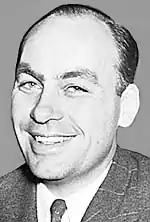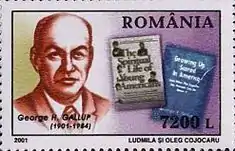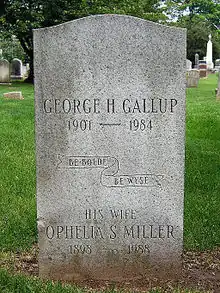George Gallup
George Horace Gallup (November 18, 1901 – July 26, 1984) was an American pioneer of survey sampling techniques and inventor of the Gallup poll, a successful statistical method of survey sampling for measuring public opinion.
George Gallup | |
|---|---|
 | |
| Born | George Horace Gallup November 18, 1901 Jefferson, Iowa, United States |
| Died | July 26, 1984 (aged 82) |
| Alma mater | University of Iowa |
| Occupation | Statistician |
| Known for | Gallup poll |
Life and career


Gallup was born in Jefferson, Iowa, the son of Nettie Quella (Davenport) and George Henry Gallup, a dairy farmer.[1] As a teen, George Jr., known then as "Ted", would deliver milk and used his salary to start a newspaper at the high school, where he also played football. His higher education took place at the University of Iowa, where he was a football player, a member of the Iowa Beta chapter of the Sigma Alpha Epsilon fraternity, and editor of The Daily Iowan, an independent newspaper which serves the university campus. He earned his B.A. in 1923, his M.A. in 1925 and his Ph.D. in 1928.[2]
He then moved to Des Moines, Iowa, where he served as head of the Department of Journalism at Drake University until 1931. That year, he moved to Evanston, Illinois, as a professor of journalism and advertising at Northwestern University. The next year, he moved to New York City to join the advertising agency of Young and Rubicam as director of research (later as vice president from 1937 to 1947). He was also professor of journalism at Columbia University, but he had to give up this position shortly after he formed his own polling company, the American Institute of Public Opinion (Gallup Poll), in 1935.[3]
Gallup is often credited as the developer of public polling. In 1932, Gallup did some polling for his mother-in-law, Ola Babcock Miller, a candidate who was a long-shot from winning a position as Iowa Secretary of State. With the Democratic landslide of that year, she won a stunning victory, furthering Gallup's interest in politics.[4]
In 1936, his new organization achieved national recognition by correctly predicting, from the replies of only 50,000 respondents, that Franklin Roosevelt would defeat Alf Landon in the U.S. Presidential election. This was in direct contradiction to the widely-respected Literary Digest magazine whose poll based on over two million returned questionnaires predicted that Landon would be the winner. Not only did Gallup get the election right, he correctly predicted the results of the Literary Digest poll, as well using a random sample smaller than theirs but chosen to match it.
Twelve years later, his organization had its moment of greatest ignominy, when it predicted that Thomas Dewey would defeat Harry S. Truman in the 1948 election, by between 5 and 15%; Truman won the election by 4.5%. Gallup believed the error was mostly due to ending his polling three weeks before Election Day, thus failing to account for Truman's comeback.
In 1947, he launched the Gallup International Association, an international association of polling organizations.[5]
In 1948, with Claude E. Robinson, he founded Gallup and Robinson, Inc., an advertising research company.
In 1958, Gallup grouped all of his polling operations under what became The Gallup Organization.
Gallup died in 1984 of a heart attack at his summer home in Tschingel ob Gunten, a village in the Bernese Oberland of Switzerland. He was buried in Princeton Cemetery. His wife died in 1988, and their son, writer and pollster George Gallup, Jr., died in 2011.[6]
See also
- Approval rating
- The Gallup Organization
- Gallup & Robinson
- George H. Gallup House
- Gallup International Association
- Pollsters[7]
References
- "George Horace Gallup (1901-1984) - Find A Grave..." www.findagrave.com.
- Rogers, Everett M. "Iowa School of Journalism". Retrieved June 13, 2012.
- "George Gallup Biography". Encyclopedia of World Biography. Retrieved June 13, 2012.
- "Miller, Eunice Viola Babcock – The Biographical Dictionary of Iowa -The University of Iowa". uipress.lib.uiowa.edu.
- Wolfgang Donsbach and Michael W. Traugott (2007). The SAGE handbook of public opinion research. Social Science.
- "N.Y. Times reporter Tom Wicker was acclaimed for Kennedy assassination coverage". Detroit Free Press. November 26, 2011. Archived from the original on February 2, 2014. Retrieved November 26, 2011.
- Kenneth F Warren (February 15, 2018). In Defense Of Public Opinion Polling. Routledge, 2018. ISBN 9780429979538.
Bibliography
- Cantril, Hadley. Gauging Public Opinion (1944)
- Cantril, Hadley and Mildred Strunk, eds. Public Opinion, 1935–1946 (1951), massive compilation of many public opinion polls from US, UK, Canada, Australia, and elsewhere. online
- Converse, Jean M. Survey Research in the United States: Roots and Emergence 1890–1960 (1987), the standard history
- Doktorov, Boris Z. "George Gallup: Biography and Destiny." Moscow: (2011)
- Foley, Ryan J., Gallup Papers Give Glimpse into US Polling History, Associated Press (2012)
- Gallup, George. Public Opinion in a Democracy (1939)
- Gallup, George, and Evan Hiill. The Secrets of Long Life (Geis Associates/Random House, 1960).
- Gallup, Alec M. ed. The Gallup Poll Cumulative Index: Public Opinion, 1935–1997 (1999) lists 10,000+ questions, but no results
- Gallup, George Horace, ed. The Gallup Poll; Public Opinion, 1935–1971 3 vol (1972) summarizes results of each poll.
- Hawbaker, Becky Wilson. "Taking 'the Pulse of Democracy': George Gallup, Iowa, and the Origin of the Gallup Poll." The Palimpsest 74(3) 98–118. Description of Gallup's Iowa years and their impact on his development.
- Lavrakas, Paul J. et al. eds. Presidential Polls and the News Media (1995)
- Moore, David W. The Superpollsters: How They Measure and Manipulate Public Opinion in America (1995)
- Ohmer, Susan (2006). George Gallup in Hollywood. Columbia University Press. ISBN 978-0-231-12133-0.
- Rogers, Lindsay. The Pollsters: Public Opinion, Politics, and Democratic Leadership (1949)
- Traugott, Michael W. The Voter's Guide to Election Polls 3rd ed. (2004)
- Young, Michael L. Dictionary of Polling: The Language of Contemporary Opinion Research (1992)
External links
| Wikimedia Commons has media related to George Gallup. |
| Wikiquote has quotations related to: George Gallup |
| Non-profit organization positions | ||
|---|---|---|
| Preceded by Henry Bruère |
President of the National Municipal League December 1953 – November 1956 |
Succeeded by Cecil Morgan |